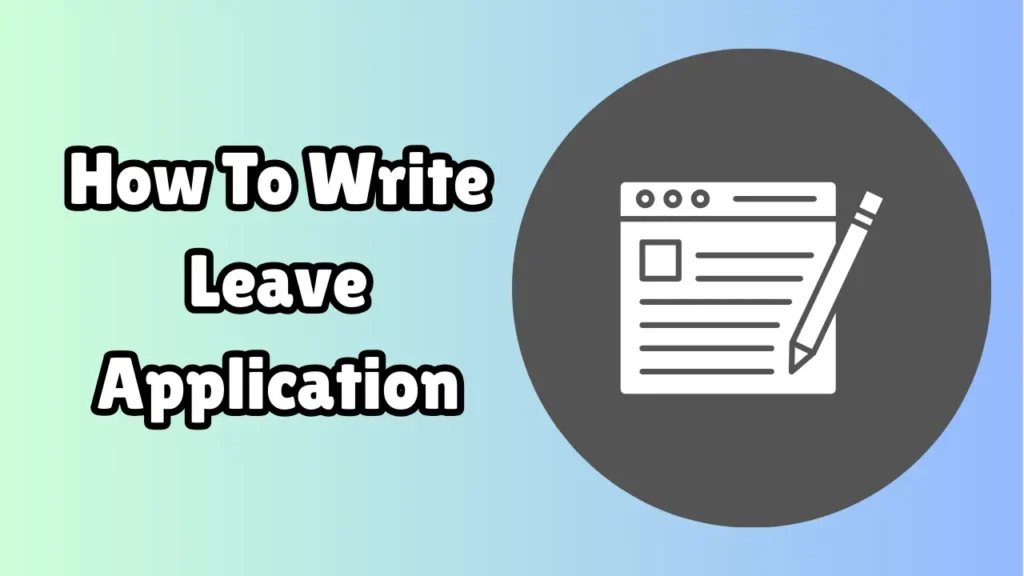How to Write a Leave Application

Writing a leave application might seem straightforward, but crafting a clear, professional, and respectful request is key to ensuring it’s approved smoothly. Whether you’re a student, employee, or professional, knowing how to write an effective leave application can make a big difference. In this guide, we’ll explore the purpose of a leave application, its essential components, and provide practical tips and examples to help you write one confidently.
What Is a Leave Application?
A leave application is a formal written request to take time off from work, school, or any other duty for a specific period. It outlines the reason for the leave, the duration, and other relevant details. Depending on the context—school, office, or personal—a leave application can be submitted as a printed letter or via email.
A well-written leave application:
-
Communicates your need clearly
-
Maintains professionalism and courtesy
-
Provides sufficient notice and details
Types of Leave Applications
There are different reasons why someone might request leave, including:
-
Casual Leave (personal work, travel, rest)
-
Sick Leave
-
Maternity/Paternity Leave
-
Emergency Leave
-
Annual Leave
-
Study Leave
-
Bereavement Leave
Each type may require a slightly different tone and supporting documents (e.g., a medical certificate for sick leave).
Key Components of a Leave Application
A well-structured leave application should include the following parts:
-
Recipient Details: Name, designation, and department of the person you’re addressing.
-
Date: The date on which you’re writing the application.
-
Subject Line: A concise summary of the purpose of the letter.
-
Salutation: A polite greeting (e.g., “Dear Sir/Madam”).
-
Body of the Letter:
-
Reason for leave
-
Duration (from and to dates)
-
Assurance of work continuity or delegation
-
-
Closing and Signature: Polite closing (e.g., “Sincerely”) followed by your name, designation, and contact details.
How to Write a Leave Application: Step-by-Step
Step 1: Start with a Clear Subject Line
Keep the subject line specific and direct:
-
Example: Subject: Application for Sick Leave from May 10 to May 12
Step 2: Address the Right Person
Use a respectful greeting and mention the correct designation.
-
Dear [Manager’s Name]/Sir/Madam
Step 3: Mention the Reason for Leave
Be honest but concise. There’s no need to go into unnecessary details.
-
“I am feeling unwell and have been advised to take rest by my doctor.”
Step 4: Specify the Duration
Clearly state the start and end dates of your leave.
-
“I request leave from May 10 to May 12, 2025.”
Step 5: Offer Alternatives or Assure Continuity
Show responsibility by mentioning how your tasks will be handled.
-
“I have handed over my responsibilities to my colleague, John Doe.”
Step 6: End on a Polite Note
Close with gratitude and a courteous line.
-
“Thank you for considering my request.”
Step 7: Sign Off
Use a professional closing and include your name and contact info.
-
Sincerely, [Your Name]
Sample Leave Applications
1. Casual Leave (Employee)
Subject: Request for Casual Leave on May 15 and 16
Dear [Manager’s Name],
I am writing to request casual leave for two days, May 15 and 16, as I have some personal matters to attend to that require my presence.
During my absence, I have ensured that my current projects are on track and have informed my team about the pending tasks. Please let me know if any additional information is needed.
Thank you for your understanding.
Sincerely,
[Your Full Name]
[Your Position]
[Contact Info]
2. Sick Leave (Student)
Subject: Sick Leave Application for Three Days
Dear Class Teacher,
I am [Your Name], a student of Class 10-B. I am suffering from a high fever and have been advised bed rest by my doctor. Hence, I will not be able to attend school from May 10 to May 12, 2025.
I kindly request you to grant me sick leave for these three days. I will make sure to catch up on all the missed lessons.
Yours obediently,
[Student’s Name]
[Roll Number]
[Parent’s Contact Info]
3. Maternity Leave (Office)
Subject: Application for Maternity Leave
Dear HR Manager,
I am writing to formally request maternity leave beginning from June 1, 2025, as my due date is approaching. I would like to avail the full 12-week leave as per company policy.
I have documented all current assignments and shared project updates with my team to ensure a smooth handover. Please let me know if any further documentation is required to process this request.
Best regards,
[Your Full Name]
[Your Designation]
[Employee ID]
[Contact Number]
Tips for Writing a Leave Application
-
Be Honest but Professional: Always keep the tone formal and respectful.
-
Plan Ahead: If possible, submit your leave application in advance.
-
Use Formal Language: Avoid slang, abbreviations, or overly casual phrases.
-
Proofread: Check for grammar and spelling mistakes.
-
Attach Supporting Documents: When required (like a doctor’s note or travel ticket), include the necessary files.
Email vs. Handwritten Leave Applications
In most workplaces and educational institutions today, email is the standard way to submit a leave request. Use a professional email format, clear subject line, and proper salutation. However, in traditional schools or organizations, a handwritten or printed application may still be expected.
Email Example Subject Line: Leave Application: May 10–12 (John Doe)
Conclusion
Writing a leave application is an essential skill for students and professionals alike. Whether you’re feeling under the weather, attending a family event, or preparing for a life milestone like maternity, the ability to communicate clearly and respectfully can help avoid misunderstandings and show your sense of responsibility.
Always remember to:
-
Be specific
-
Provide adequate notice
-
Keep it polite and professional
Mastering the art of writing a leave application ensures you maintain trust, professionalism, and good relationships within your organization or institution.